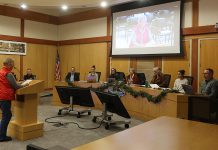Number of votes still to be tallied could sway final results
Two county-wide and one state-wide ballot measure were up for vote on Tuesday, March 3, and the decision of the voters isn’t entirely clear.
In part this is due to close races, and in part this is due to the large number of mail-in ballots still to be counted, which in closer races could have an impact on the final outcome. State elections now work on the so-called E+3 system, which means registrars have to count ballots received up to three days after the election provided they are postmarked on or before Alection Day.
Eighty percent of county voters have mail-in ballots, and only 31% of those had been returned prior to Tuesday.
The results will not be certified until March 31, 28 days after the election. All vote counts listed below are as of 8 a.m. on March 4.
Measure I
Measure I is teetering on the edge, and proponents believe mathematically they’ve lost. The vote count showed it being defeated by the slimmest of margins, 50,855 against and 50,606 in favor, however, a 2/3 majority is required for adoption.
“Mathematically we don’t think we’ll get there,” said SMART board member Debora Fudge.
Measure I asked voters whether the existing quarter-cent sales tax for SMART should be extended for an additional 30 years through March 31, 2059. If approved, Measure I would provide approximately $40 million annually, according to the county counsels’ impartial analysis published in the voter guide.
The argument between the two sides grew heated as the campaign wore on, with huge amounts of money being thrown around on both sides. Opponents believed the level of rider subsidization through extended tax debt and lack of transparency into finances. Proponents felt that the refinancing of current bonds and the increased availability of grant funding following the refinancing will allow them to complete the route faster and remain solvent well into the future. The refinanced bonds would have saved tax payers $12 million a year.
“This has been an election like no other,” said Fudge. “While we’re disheartened by the outcome, were going to continue to move forward with the work the community has entrusted us with. We have to work to increase awareness of the value the train adds to the community.”
Fudge says the board will now have to evaluate where they go from here. “(We have) a meeting March 18 and we’ll begin the difficult process of identifying where we can make cuts. It won’t be easy, but as a community we’ll navigate this difficult stretch; and the community will be able to have input through the meetings and the citizens’ oversight committee to review proposed budget cuts.”
Measure G
Measure G is in the same boat, though unlike Measure I it had an easy majority, 62,564 votes in favor versus 38,714 against. However, the votes in favor did not reach the necessary threshold, capturing 61% of the votes instead of the needed 66%.
Measure G will add a half-cent to sales tax throughout the county and was born out of a recognition that the current county-wide fire and emergency service delivery structure, funding and system structure is inadequate and does not meet National Fire Protection Association (NFPA) standards.
The Sonoma County Board of Supervisors and fire officials made the rounds at local city council meetings, pitching Measure G to the local municipalities. Among the items the measure would fund include a substantial increase in staffing throughout the local fire system, adding 200-plus full-time staff throughout the county, including firefighters, vegetation management and fire prevention staff and additional battalion chiefs for regional command and control leadership.
No official “against” campaign was mounted against Measure G.
Proposition 13
Proposition 13 asked if the state could sell $15 billion in general obligation bonds to fund school, community college and university facility projects. In addition, school districts and community college districts would be authorized to issue additional local bonds and school districts would have new limits on their ability to levy developer fees.
Nine billion dollars would go to public schools, mostly for renovation projects, and $6 billion will go to public higher education facilities, split evenly between community colleges, the California State University system and the University of California system. The bond is projected to cost $740 million a year over 35 years to repay the principal with interest.
While there was some panic due to the unfortunate name, and fears that voting on it would effect the landmark 1978 measure which cut property taxes, in general there has been minimal argument against other than a general dissatisfaction with additional taxes.
Possibly because of the name issue, the measure was soundly defeated, with statewide numbers showing 55.9% against and 44.1% for. Locally, the numbers were closer with 50.61% in favor, and 49.39% against.









